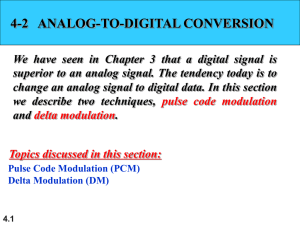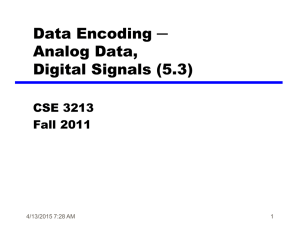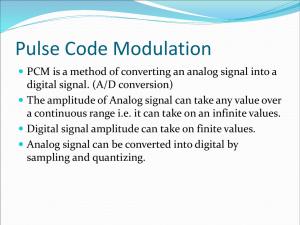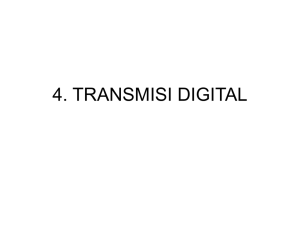File
advertisement
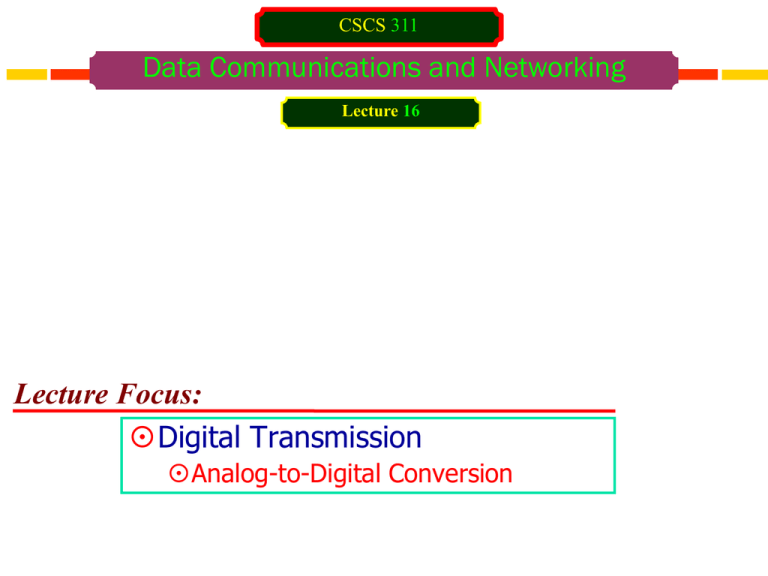
CSCS 311 Data Communications and Networking Lecture 16 Lecture Focus: Digital Transmission Analog-to-Digital Conversion Digital Transmission Digital-to-digital conversion techniques, methods which convert digital data to digital signals. Analog-to-digital conversion techniques, methods which change an analog signal to a digital signal. Digital Data Digital Signal Analog Signal Digital Transmission ANALOG-TO-DIGITAL CONVERSION Sometimes, we have an analog signal such as one created by a microphone or camera. A digital signal is superior to an analog signal. The tendency today is to change an analog signal to digital data. Two techniques: Pulse Code Modulation (PCM) Delta Modulation (DM) After the digital data are created (digitization), we can use one of the techniques discussed earlier. ANALOG-TO-DIGITAL CONVERSION Pulse Code Modulation (PCM) The most common technique to change an analog signal to digital data (digitization) is called pulse code modulation (PCM). A PCM encoder has three processes (SQE): 1. The analog signal is sampled. 2. The sampled signal is quantized. 3. The quantized values are encoded as streams of bits. ANALOG-TO-DIGITAL CONVERSION Pulse Code Modulation (PCM) ANALOG-TO-DIGITAL CONVERSION Pulse Code Modulation (PCM) Sampling The first step in PCM The analog signal is sampled every Tss: Ts is the sample interval or period. The inverse of the sampling interval is called the sampling rate or sampling frequency and denoted by fs, where fs = 1 / Ts ANALOG-TO-DIGITAL CONVERSION Pulse Code Modulation (PCM) Sampling The sampling process is sometimes referred to as pulse amplitude modulation (PAM). The result is still an analog signal with non-integral values. ANALOG-TO-DIGITAL CONVERSION Pulse Code Modulation (PCM) Sampling ANALOG-TO-DIGITAL CONVERSION Pulse Code Modulation (PCM) Sampling Sampling Rate: Nyquist theorem: “To reproduce the original analog signal, one necessary condition is that the sampling rate be at least twice the highest frequency in the original signal”. ANALOG-TO-DIGITAL CONVERSION Pulse Code Modulation (PCM) Sampling First, we can sample a signal only if the signal is band-limited. A signal with an infinite bandwidth cannot be sampled. Second, the sampling rate must be at least 2 times the highest frequency, not the bandwidth. If the analog signal is low-pass, the bandwidth and the highest frequency are the same value. If the analog signal is bandpass, the bandwidth value is lower than the value of the maximum frequency. ANALOG-TO-DIGITAL CONVERSION Pulse Code Modulation (PCM) Sampling Figure below shows the value of the sampling rate for two types of signals. Amplitude Nyquist Rate = 2 x fmax Low pass signal fmax fmin Frequency Amplitude Nyquist Rate = 2 x fmax Bandpass signal 0 fmin fmax Frequency ANALOG-TO-DIGITAL CONVERSION Pulse Code Modulation (PCM) Sampling Example: Telephone companies digitize voice by assuming a maximum frequency of 4000 Hz. The sampling rate therefore is 8000 samples per second. Example: A complex low-pass signal has a bandwidth of 200 kHz. What is the minimum sampling rate for this signal? Solution The bandwidth of a low-pass signal is between 0 and f where f is the maximum frequency in the signal. The sampling rate is therefore 400,000 samples per second. ANALOG-TO-DIGITAL CONVERSION Pulse Code Modulation (PCM) Sampling Example: A complex bandpass signal has a bandwidth of 200 kHz. What is the minimum sampling rate for this signal? Solution: We cannot find the minimum sampling rate in this case because we do not know where the bandwidth starts or ends. We do not know the maximum frequency in the signal. ANALOG-TO-DIGITAL CONVERSION Pulse Code Modulation (PCM) Sampling Example: What sampling rate is needed for a signal with a bandwidth of 10,000 Hz (1000 to 11,000 Hz)? Solution: Sampling rate = 2 x (11,000) = 22,000 samples/s ANALOG-TO-DIGITAL CONVERSION Pulse Code Modulation (PCM) Sampling Example: A signal is sampled. Each sample requires at least 12 levels of precision (+0 to +5 and -0 to -5). How many bits should be sent for each sample? Solution: We need 4 bits; 1 bit for the sign and 3 bits for the value. A 3-bit value can represent 23 = 8 levels (000 to 111), which is more than what we need. A 2-bit value is not enough since 22 = 4. A 4-bit value is too much because 24 = 16. ANALOG-TO-DIGITAL CONVERSION Pulse Code Modulation (PCM) Quantization The result of sampling is a series of pulses with amplitude values between the maximum and minimum amplitudes of the signal. The set of amplitudes can be infinite with non-integral values between the two limits. These values cannot be used in the encoding process. ANALOG-TO-DIGITAL CONVERSION Pulse Code Modulation (PCM) Quantization Steps in quantization 1. We assume that the original analog signal has instantaneous amplitudes between Vmin and Vmax. 2. We divide the range into L zones, each of height (delta). = (Vmax – Vmin) / L 3. We assign quantized values of 0 to L - 1 to the midpoint of each zone. 4. We approximate the value of the sample amplitude to the quantized values. Example: Assume that we have a sampled signal and the sample amplitudes between -20 and +20 V. We decide to have eight levels (L = 8). This means that =5 V. Figure below shows this example. ANALOG-TO-DIGITAL CONVERSION Pulse Code Modulation (PCM) Quantization Normalized amplitude 7 4 6 3 5 2 4 3 2 1 0 16.2 19.7 11.0 7.5 Time 0 - -6.1 -5.5 -2 -9.4 -6.0 -11.3 -3 -4 NPV NQV NE QC EW -1.22 -1.50 -0.38 2 010 1.50 3.24 3.94 1.50 3.50 3.50 0 +0.26 -0.44 5 7 7 101 111 111 2.20 2.50 +0.30 6 110 -1.10 -1.50 -0.40 2 010 -2.26 -2.50 -0.24 1 001 -1.88 -1.50 +0.38 2 010 -1.20 -1.50 -0.30 2 010 NPV = Normalized PAM Values NQV = Normalized Quantized Values NE = Normalized Error = NQV-NPV QC = Quantization Code EW = Encoded Words ANALOG-TO-DIGITAL CONVERSION Pulse Code Modulation (PCM) Quantization Normalized amplitude 7 4 6 3 5 2 4 3 2 1 0 16.2 19.7 11.0 7.5 Time 0 - -6.1 -5.5 -2 -9.4 -6.0 -11.3 -3 -4 NPV NQV NE QC EW -1.22 -1.50 -0.38 2 010 1.50 3.24 3.94 1.50 3.50 3.50 0 +0.26 -0.44 5 7 7 101 111 111 2.20 2.50 +0.30 6 110 -1.10 -1.50 -0.40 2 010 -2.26 -2.50 -0.24 1 001 -1.88 -1.50 +0.38 2 010 -1.20 -1.50 -0.30 2 010 The value at the top of each sample in the graph shows the actual amplitude. The first row is the normalized value for each sample (actual amplitude/). The quantization process selects the quantization value from the middle of each zone. This means that the normalized quantized values (second row) are different from the normalized amplitudes. The difference is called the normalized error (third row). The fourth row is the quantization code for each sample based on the quantization levels at the left of the graph. The encoded words (fifth row) are the final products of the conversion. ANALOG-TO-DIGITAL CONVERSION Pulse Code Modulation (PCM) Quantization Quantization Levels: The choice of L, the number of levels, depends on the range of the amplitudes of the analog signal and how accurately we need to recover the signal. If the amplitude of a signal fluctuates between two values only, we need only two levels. If the signal, like voice, has many amplitude values, we need more quantization levels. In audio digitizing, L is normally chosen to be 256. In video it is normally thousands. Choosing lower values of L increases the quantization error if there is a lot of fluctuation in the signal. Increasing the number of levels increases the SNR. ANALOG-TO-DIGITAL CONVERSION Pulse Code Modulation (PCM) Quantization Quantization Error: Quantization is an approximation process. The input values to the quantizer are the real values; the output values are the approximated values. The output values are chosen to be the middle value in the zone. If the input value is also at the middle of the zone, there is no quantization error; otherwise, there is an error. In the previous example, the normalized amplitude of the third sample is 3.24, but the normalized quantized value is 3.50. This means that there is an error of +0.26. The value of the error for any sample is less than /2. In other words, we have - /2 <= error <= - /2. Quantization error to the SNRdB: SNRdB =6.02nb + 1.76 Db where nb = number of bits per sample ANALOG-TO-DIGITAL CONVERSION Pulse Code Modulation (PCM) Quantization Quantization error to the SNRdB: SNRdB =6.02nb + 1.76 Db where nb = number of bits per sample Example: What is the SNRdB in the example of above figure? Solution: We have eight levels and 3 bits per sample, so SNRdB =6.02(3) + 1.76 = 19.82 dB. ANALOG-TO-DIGITAL CONVERSION Pulse Code Modulation (PCM) Quantization Quantization error to the SNRdB: SNRdB =6.02nb + 1.76 Db where nb = number of bits per sample Example: A telephone subscriber line must have an SNRdB above 40. What is the minimum number of bits per sample? Solution: We can calculate the number of bits as SNRdB =6.02(nb) + 1.76 = 40 nb = 6.35 Telephone companies usually assign 7 or 8 bits per sample. ANALOG-TO-DIGITAL CONVERSION Pulse Code Modulation (PCM) Quantization ANALOG-TO-DIGITAL CONVERSION Pulse Code Modulation (PCM) Encoding The last step in PCM is encoding. After each sample is quantized and the number of bits per sample is decided, each sample can be changed to an nb-bit code word. In previous figure, the encoded words are shown in the last row. A quantization code of 2 is encoded as 010; 5 is encoded as 101; and so on. Note that the number of bits for each sample is determined from the number of quantization levels. If the number of quantization levels is L, number of bits is nb=log2 L. The bit rate can be found from the formula: Bit rate = sampling rate x number of bits per sample = fs x nb ANALOG-TO-DIGITAL CONVERSION Pulse Code Modulation (PCM) Encoding Bit rate = sampling rate x number of bits per sample = fs x nb Example: We want to digitize the human voice. What is the bit rate, assuming 8 bits per sample? Solution: The human voice normally contains frequencies from 0 to 4000 Hz. So the sampling rate and bit rate are calculated as follows: Sampling rate = 4000 x 2 = 8000 samples/s Bit rate = 8000 x 8 = 64,000 bps = 64 kbps ANALOG-TO-DIGITAL CONVERSION Pulse Code Modulation (PCM) Encoding ANALOG-TO-DIGITAL CONVERSION Pulse Code Modulation (PCM) ANALOG-TO-DIGITAL CONVERSION Pulse Code Modulation (PCM) Assignment Q1 Decoding Discuss the working of PCM Decoder with the help of a diagram. Q2 Delta Modulation (DM) Discuss the working of DM Technique. Explain with the help of an example. Transmission Mode Parallel Transmission Serial Transmission Transmission Mode Parallel Transmission Transmission Mode Serial Transmission Transmission Mode Asynchronous Transmission Asynchronous transmission is so named because the timing of a signal is unimportant. Instead, information is received and translated by agreed upon patterns. As long as those patterns are followed, the receiving device can retrieve the information without regard to the rhythm in which it is sent. Patterns are based on grouping the bit stream into bytes. Each group, usually 8 bits, is sent along the link as a unit. The sending system handles each group independently, relaying it to the link whenever ready, without regard to a timer. Without synchronization, the receiver cannot use timing to predict when the next group will arrive. To alert the receiver to the arrival of a new group, therefore, an extra bit is added to the beginning of each byte. This bit, usually a 0, is called the start bit. To let the receiver know that the byte is finished, 1 or more additional bits are appended to the end of the byte. These bits, usually I s, are called stop bits. By this method, each byte is increased in size to at least 10 bits, of which 8 bits is information and 2 bits or more are signals to the receiver. In addition, the transmission of each byte may then be followed by a gap of varying duration. This gap can be represented either by an idle channel or by a stream of additional stop bits. Transmission Mode Asynchronous Transmission In asynchronous transmission, we send 1 start bit (0) at the beginning and 1 or more stop bits (1s) at the end of each byte. There may be a gap between each byte. Asynchronous here means “asynchronous at the byte level,” but the bits are still synchronized; their durations are the same. The start and stop bits and the gap alert the receiver to the beginning and end of each byte and allow it to synchronize with the data stream. Within each byte, the receiver must still be synchronized with the incoming bit stream. That is, some synchronization is required, but only for the duration of a single byte. When the receiver detects a start bit, it sets a timer and begins counting bits as they come in. After n bits, the receiver looks for a stop bit. As soon as it detects the stop bit, it waits until it detects the next start bit. Transmission Mode Asynchronous Transmission Transmission Mode Asynchronous Transmission The addition of stop and start bits and the insertion of gaps into the bit stream make asynchronous transmission slower than forms of transmission that can operate without the addition of control information. But it is cheap and effective, two advantages that make it an attractive choice for situations such as low-speed communication. For example, the connection of a keyboard to a computer is a natural application for asynchronous transmission. A user types only one character at a time, types extremely slowly in data processing terms, and leaves unpredictable gaps of time between each character. Transmission Mode Synchronous Transmission In synchronous transmission, we send bits one after another without start/stop bits or gaps. It is the responsibility of the receiver to group the bits. In synchronous transmission, the bit stream is combined into longer "frames," which may contain multiple bytes. Each byte, however, is introduced onto the transmission link without a gap between it and the next one. It is left to the receiver to separate the bit stream into bytes for decoding purposes. In other words, data are transmitted as an unbroken string of 1s and 0s, and the receiver separates that string into the bytes, or characters, it needs to reconstruct the information. Transmission Mode Synchronous Transmission Transmission Mode Synchronous Transmission Without gaps and start and stop bits, there is no built-in mechanism to help the receiving device adjust its bit synchronization midstream. Timing becomes very important, therefore, because the accuracy of the received information is completely dependent on the ability of the receiving device to keep an accurate count of the bits as they come in. The advantage of synchronous transmission is speed. With no extra bits or gaps to introduce at the sending end and remove at the receiving end, and, by extension, with fewer bits to move across the link, synchronous transmission is faster than asynchronous transmission. For this reason, it is more useful for high-speed applications such as the transmission of data from one computer to another. Byte synchronization is accomplished in the data link layer. Although there is no gap between characters in synchronous serial transmission, there may be uneven gaps between frames. Transmission Mode Isochronous Transmission In real-time audio and video, in which uneven delays between frames are not acceptable, synchronous transmission fails. For example, TV images are broadcast at the rate of 30 images per second; they must be viewed at the same rate. If each image is sent by using one or more frames, there should be no delays between frames. For this type of application, synchronization between characters is not enough; the entire stream of bits must be synchronized. The isochronous transmission guarantees that the data arrive at a fixed rate.
